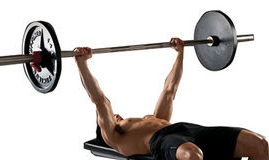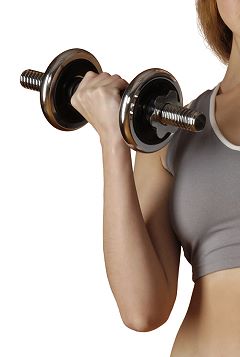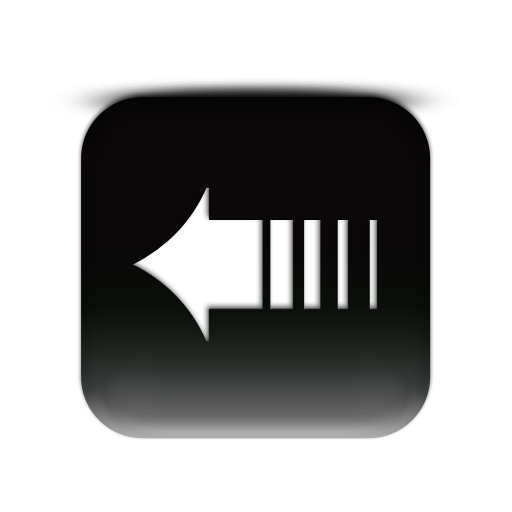If you've found this website helpful, please click the Donate button. Thanks for the support.
Find this page useful and think a friend might too? Share it!
Find this page useful and think a friend might too? Share it!
Exercise Guide
Like the site? Sign up for the FREE newsletter. I'll send a new article once or twice a month. Unsubscribe
anytime.
anytime.
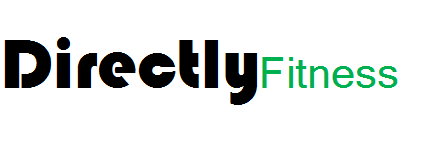
About this Site l Contact l Free Newsletter l Subscribe to Rss Feed
Recommended Products l Fitness Store l Directly Fitness Blog
Recommended Products l Fitness Store l Directly Fitness Blog
Continue to learn more about how to exercise in the Exercise Guide.
HOW TO EXERCISE
1. The Dead Lift
Note:
This is a complex movement and takes practice before attempting to move heavy weight. This movement can be mastered using only your own bodyweight first to avoid injury.
Starting Position:
• Begin by standing in front of a barbell on the ground, feet slightly
wider than shoulder width, with toes pointed slight out.
• If you find this exercise too challenging for the mechanics of your
legs, try moving feet wider as this will open up your thighs and
increase your base of support.
• Your shins should be touching or very close to the barbell.
• Squat down so you can comfortably grip the bar with arms
remaining vertical.
• One hand should be using a supinated grip (palms up) while the
other using a pronated grip (overhand grip).
• Be sure to keep your buttocks low to the ground.
• Upper body and head should be straight with an upright posture
and tight abdominals.
• Your chest and buttocks sticking should look as if you are sticking them out
Upward Phase:
• Begin by contracting your traps and tensing the connection
between the bar and your arms.
• Drive your heels into the ground and contract your buttocks while
extending at the knees.
• The two previous steps should be done essentially at the same
time (this is where practice comes in).
• Keep chest out, keep a slight arch in the small of your back, and
don’t round back! This is the most common mistake and will lead
to injury.
• Always concentrate on keeping your buttocks low and this will
reduce rounding of the back.
• Throughout movement keep the bar as close to your body as
possible. Even letting the bar ride up your shins and thighs is
ideal (wear pants or this may hurt).
• As you begin to reach the end of the movement, be sure to not
lean forward. Lean back slightly as knees are full extended. This is
the end of the up ward phase.
• Abs should be contracted throughout the movement. This is
important as it will keep the pressure around your core tight. It is
your “natural belt” which mimics many common power lifting belts.
• If you feel your core is weak, train this first and then attempt the
dead lift.
Downward Phase:
• Slowly lower the bar with your chest and buttocks sticking out.
• Make sure your body is upright!
• It is ideal to lower the bar as close to your legs as you can, just
as in the upward phase.
• It helps to keep upright posture by looking up while lowering (Neck
extension naturally influences the rest of the spine to extend).
• Make sure buttocks stays lower than your upper body as you
descend.
• Movement is complete when weight touches the ground. Avoid
dropping the weight to the ground as this can damage the floor
and very unpleasant to fellow gym members.
Tips:
• This movement is very unnatural to most and will not come easily.
Form must be learned before attempting this exercise! Try looking
at yourself in the mirror while practicing with no added weight.
• This is a high intensity exercise as almost every major muscle is
being worked! Be sure to have lots of energy and focus when
performing.
• Be sure to inhale on the way down and exhale on the way up! If
you hold your breath in you risk passing out in the middle of the
movement!
2. Bent-Over Barbell Rows
(Over or Under handed Grip)
Starting Position:
• Begin Standing shoulder width apart with the barbell on the floor
or up on a rack.
• Squat at the knees to get arms length to the barbell.
• You can use an overhand or underhand grip approximately shoulder
width.
• Keeping a slight arch in your back and buttocks out, extend at the
knees and back until your back is slightly less than 45 degrees
from the standing position.
• Knees should be bent enough so that arms and barbell is hanging
straight down just in front of the knees.
• Keep neck straight and in line with your flat back (Do not round
back!).
• Be sure not to lean forward and don’t allow trunk to move past
knees.
Upward Phase:
• Pull weight up to the bottom of your sternum (just below the pec
line).
• Retract your shoulder blades back while extending your arms back.
• Keep legs, trunk, and neck a still as possible throughout motion.
• Stop motion once upper arms are parallel to your trunk.
• Exhale while lifting the weight up.
Downward Phase:
• Allow weight to slowly extend in a controlled fashion.
• Keep the flat back with a slight arch to avoid injury!
• Back and neck should be in a straight line.
• Don’t allow trunk to lean past knees.
• Motion is complete when arms are extended just before extension.
• Inhale while letting the weight down.
Tips:
• If you have trouble keeping your trunk from leaning forward try
focusing on leaning back on your heels.
• Try using a smith machine when first learning this exercise so your
action is “guided” and then move on to the free weights.
• Use the underhand position to incorporate the biceps in the
movement.
• Use overhand to isolate the lats a little more.
3. Bent-Over Dumbbell Rows
Starting Position:
• Begin Standing shoulder width apart with the dumbbells in hand.
• Squat down at the knees.
• Use the over hand grip and can even keep a slight supinated hand
position (palms slightly facing each other).
• Keeping a slight arch in your back and buttocks out, extend at the
knees and back until your back is slightly less than 45 degrees
from the standing position.
• Knees should be bent enough so that arms and dumbbells are
hanging straight down just in front of the knee.
• Keep neck straight and in line with your flat back (Do not round b
ack!).
• Be sure not to lean forward and don’t allow trunk to move past
knees
Upward Phase:
• Pull weight up to the bottom of your sternum (just below the pec
line).
• Retract your shoulder blades back while extending your arms back.
• Keep legs, trunk, and neck a still as possible throughout motion.
• Stop motion once upper arms are parallel to your trunk.
• Exhale while lifting the weight up.
Downward Phase:
• Allow weight to slowly extend in a controlled fashion.
• Keep the flat back with a slight arch to avoid injury!
• Back and neck should be in a straight line.
• Don’t allow trunk to lean past knees.
• Motion is complete when arms are extended just before extension.
• Inhale while letting the weight down.
Tips:
• If you have trouble keeping your trunk from leaning forward try
focusing on leaning back on your heels.
• Try using a smith machine when first learning this exercise so your
action is “guided” and then move on to the free weights.
• Use the underhand position to incorporate the biceps in the
movement.
• Use overhand to isolate the lats a little more
4. Cable Rows (Seated)
Starting Position:
• Begin by sitting on the bench with an upright posture.
• Place feet on the foot platform.
• Be sure to keep feet straight and not pointed out to the sides.
• Grab grip while keeping a flat back (Do not round at any point!).
• With grip in hand extend at the hips until you’re in the upright
posture.
• Your arms should almost straightened in front of you with the
weight in hand.
Upward Phase:
• Begin by retracting your shoulder blades back while extending your
arms.
• Don’t allow your elbows to flare out.
• Be sure to pinch your shoulder blades together and hold for a
second at the top of the movement.
• Keep upright posture and slight arch in back throughout
movement!
• Knees should not come unbent, nor bend more
Downward Phase:
• Slowly control the weight back to just before your body begins to
lean forward.
• Keep your upright posture and arch in your back.
• Don’t bend at the knees anymore than you already are.
• Feel the stretch in your lats prior to beginning the next rep to get
the full range of motion.
Tips:
• Some foot platforms are so far forward that to bend over to grab
the grip you would have to flex very far forward and sets you up
for injury. Try grabbing grip and then placing feet on platform.
Grab grip first, then lean back while standing and step back to sit.
Slowly place one foot on platform followed by the other.
5. Cable Rows (Standing)
Starting Position:
• Begin by standing facing the cable tower with the grip set belly
button height.
• Place feet flat on the ground and bend at knees until grip is at
level with the sternum.
• Be sure to keep feet straight and not pointed out to the sides.
• Grab grip while keeping a flat back (Do not round at any point!).
• Back up until there is excess motion in the cable even with
straightened arms.
• Stick chest out, keep neck straight, and abdominals tightened
Upward Phase:
• Begin by retracting your shoulder blades back while extending your
arms.
• Don’t allow your elbows to flare out.
• Be sure to pinch your shoulder blades together and hold for a
second at the top of the movement.
• Keep upright posture and slight arch in back throughout
movement!
• Knees should not come unbent, nor bend more.
• The only motion from your body should be your arms (and
retraction of back).
Downward Phase:
• Slowly control the weight back to just before your body begins to
lean forward.
• Keep your upright posture and arch in your back.
• Don’t bend at the knees anymore than you already are.
• Feel the stretch in your lats prior to beginning the next rep to get
the full range of motion.
Tips:
• Try variations in the height of the cable pulley. To train lower
traps, place the pulley higher. To train upper traps place it lower.
It is explained here to train a little of both or focus in the middle
6. Lat-Pulldowns
Starting Position:
• Grip the bar with an over-hand grip and slowly get into the seated
position.
• Make sure upper thigh pad is placed firmly onto the tops of your
thighs just above the knee (Set this prior to grabbing weight).
• Don’t allow pad right on knees, sit forward so this doesn’t happen.
• Lean back slightly from the upright posture and don’t allow back to
hunch over.
• Feet should be flat on the floor with toes pointed forward
Downward Phase:
• Retract shoulder blades down and back while pulling the weight
straight down to meet your sternum.
• Keep abdominals tight throughout motion.
• Breathe out as you pull the weight down.
• Elbows should be out at 90 degrees (using a flat bar), don’t allow
them to go inwards.
• Movement is complete when you can reach your sternum or can no
longer retract your shoulder blades down and back.
• Do not heave the weight down! Only slight motions should occur in
the trunk.
Upward Phase:
• Allow weight to slowly reach back up to the starting position.
• Control the motion by letting the bar back up slowly.
• Keep back in the same slightly leaned back posture.
• Feet should remain flat on the floor.
Tips:
• If your shoulders get tight or uncomfortable in the fully contracted
position, don’t pull bar all the way down to sternum, stop a few
inches above.
• Try a couple of different grips such as a rope type grip. This gives
your lats an extra challenge because of the accessory movements
caused by the rope.
7. Chin-Ups
Starting Position:
• Begin by gripping the bar with a supinated (underhand) grip.
• Grip should be more narrow than shoulder width.
• Arms and body should be straight and hanging down from bar.
• You may cross your lower legs or let your legs hang naturally.
Upward Phase:
• Pull upward while increasing flexion at your elbow.
• You should feel your biceps contract.
• Try not to swing your body to pull up.
• Motion is complete once your chin is over the bar.
Downward Phase:
• Slowly lower yourself down just before your reach the starting
position.
• Lowering too fast will result in full arm extension and elbow injury.
• Don’t allow elbows to flare out and keep them in line with your
forearms.
Tips:
• Try to contract with your lats as well as your biceps. Some will
overuse their biceps and take away much of the purpose and
benefits of this exercise.
• If you find your body swinging frequently try to cross your lower
legs.
• If you cannot perform many pull-ups consider using a “Pull-up
machine” which are quite common in fitness gyms and assist you
so you may perform more repetitions.
8. Pull-Ups
Starting Position:
• Begin by gripping the bar with a pronated (overhand) grip.
• Grip should be shoulder width or slightly wider.
• Arms and body should be straight and hanging down from bar.
• You may cross your lower legs or let your legs hang naturally.
Upward Phase:
• Pull upward while increasing flexion at your elbow.
• Keep your forearms parallel with your body.
• Keep elbows out at 90 degrees from the front (midline) of your
body.
• Don’t allow elbows to flare in or out from this position.
• Try not to swing your body to pull up.
• Motion is complete once your chin is over the bar
Downward Phase:
• Slowly lower yourself down just before your reach the starting
position.
• Lowering too fast will result in full arm extension and elbow injury.
• Don’t allow elbows to flare out and keep them in that 90 degree
angle from your midline.
Tips:
• Try to contract with your lats as well as your biceps. Some will
overuse their biceps and take away much of the purpose and
benefits of this exercise.
• If you find your body swinging frequently try to cross your lower
legs.
• If you cannot perform many pull-ups consider using a “Pull-up
machine” which are quite common in fitness gyms and assist you
so you may perform more repetitions.
• If you want to make this slightly easier, use a wider grip.
• If you want to make this harder, try adding weight to your body
with ankle weights or using a weighted belt.
9. Straight Arm Pull Downs
Starting Position:
• Start by standing in front of a cable machine tower with a flat bar
grip tool attached.
• Set the cable pulley at a level above the height of your head.
• Grab bar with an overhand grip at shoulder width or slightly more
narrow.
• Stand tall, keep head, neck, and trunk in a straight upright
posture.
• Keep a slight bend in the knees throughout the exercise.
• Stand close enough to the tower so that your arms are overhead
gripping the bar and a slight bend in your elbow is present.
Downward Phase:
• With the elbows slightly bent, slowly contract your lats to pull the
bar in an arching motion towards your thighs.
• Keep an upright posture in your body.
• Do not round the back or lock out the elbows.
• Motion is complete once bar reaches the thighs.
• Concentrate on holding the position for a second while contracting
the lats.
Upward Phase:
• Slowly allow the weight to be pulled back up through the arching
motion.
• Control the weight back with your lats.
• Keep the slight bend in your elbows.
• Stop just short of the starting position to keep tension on your
muscles.
• When finished with all repetitions slowly allow the weight back all
the way.
• Don’t allow weight to slam back.
Tips:
• Try using various grips for this exercise. For a greater squeeze in
your lats, try using a rope grip instead of a flat bar.
• Try an underhand grip for more triceps involvement but remember
to keep only a slight bend in the elbows. The amount of weight
used in this position will also be lower.
Upper Back Exercises:
(In order of appearance)
1. Dead Lift
2. Bent-Over Barbell Rows
3. Bent-Over Dumbbell Rows
4. Seated Cable Rows
5. Standing Cable Rows
6. Lat Pull-downs
7. Chin-ups
8. Pull-ups
9. Straight Arm Pull Downs
(In order of appearance)
1. Dead Lift
2. Bent-Over Barbell Rows
3. Bent-Over Dumbbell Rows
4. Seated Cable Rows
5. Standing Cable Rows
6. Lat Pull-downs
7. Chin-ups
8. Pull-ups
9. Straight Arm Pull Downs
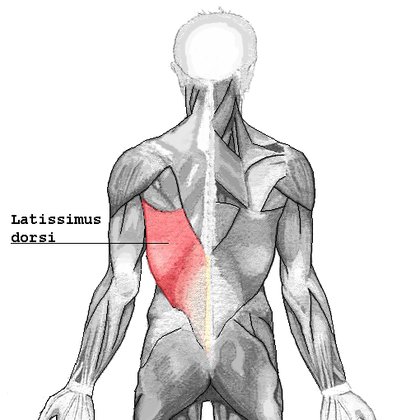
LATISSIMUS DORSI
Exercise:
